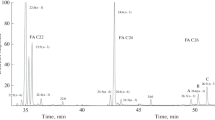Abstract
A series of novel C18–C22 trans ω3 polyunsaturated fatty acids (PUFA) with a single trans double bond in the ω3 position was found in Northern and Southern Hemisphere strains of the marine haptophyte Imantonia rotunda. The novel ω3 PUFA were identified as 18:3(9c,12c,15t) (0.2–1.8 % of total fatty acids), 18:4(6c,9c,12c,15t) (1.9–4.1 %), 18:5 (3c,6c,9c,12c,15t) (0.7–8.8 %), 20:5(5c,8c,11c,14c,17t) (1.2–4.1 %) and 22:6(4c,7c,10c,13c,16c,19t) (0.3–4.3 %), and were accompanied by larger proportions of the all cis isomers: 18:3ω3(9,12,15) (2.7–3.5 %), 18:4ω3(6,9,12,15) (9.3–14.3 %), 18:5ω3(3,6,9,12,15) (7.8–18.5 %), 20:5ω3(5,8,11,14,17) (3.2–3.9 %), 22:5ω3(7,10,13,16,19) (0.1–0.3 %) and 22:6ω3(4,7,10,13,16,19) (2.3–5.2 %). GC analysis of FAME using a non-polar column did not reveal the trans isomers as they coeluted with the all cis PUFA. However, GC using a polar column resolved the trans PUFA from the all cis PUFA, with the trans isomers eluting before the all cis isomers. GC-MS of FAME fractionated by argentation solid-phase chromatography confirmed the molecular ions of all components. FAME were derivatized to form 4,4-dimethyloxazoline (DMOX) derivatives, and GC-MS revealed the same double bond positions for each trans and cis FAME. The results suggest that the ω3 trans double bond originated from the Δ15/ω3 desaturation of 18:2(9c,12c), suggesting that this desaturase has dual cis/trans activity in these species. These results indicate that 18:3(9c,12c,15 t) was the precursor trans isomer produced for the trans series and further desaturation by the common Δ6 desaturase to produce the trans tetraene and successive elongations and desaturations led to the subsequent series of trans ω3 PUFA isomers. To our knowledge, this is the first report of these trans ω3 isomers occurring in strains of I. rotunda. These trans ω3 PUFA may be used as biomarkers in marine food webs for this species and with their unique structure may be biologically active.




Similar content being viewed by others
References
Bendif EM, Probert I, Schroeder DC, Vargas C (2013) On the description of Tisochrysis lutea gen. nov. sp. nov. and Isochrysis nuda sp. nov. in the Isochrysidales, and the transfer of Dicrateria to the Prymnesiales (Haptophyta). J Appl Phycol 25:1763–1776
Brown MR, Dunstan GA, Jeffrey SW, Volkman JK, Barrett SM, Leroi J-M (1993) The influence of irradiance on the biochemical composition of the prymnesiophyte Isochrysis sp. (Clone T-Iso). J Phycol 29:601–612
Brown MR, Jeffrey SW, Volkman JK, Dunstan GA (1997) Nutritional properties of microalgae for mariculture. Aquaculture 151:315–331
Christie WW (1982) A simple procedure for rapid transmethylation of glycerolipids and cholesteryl esters. J Lipid Res 23:1072–1075
Christie WW (1989) Silver ion chromatography using solid-phase extraction columns packed with a bonded-sulfonic acid phase. J Lipid Res 30:1471–1473
Cuvelier ML, Allen AE, Monier A, Mccrow JP, Messié M, Tringe SG, Woyke T, Welsh RM, Ishoey T, Lee J-H, Binder BJ, Dupont CL, Latasa M, Guigand C, Buck KR, Hilton J, Thiagarajan M, Caler E, Read B, Lasken RS, Chavez FP, Worden AZ (2010) Targeted metagenomics and ecology of globally important uncultured eukaryotic phytoplankton. Proc Nat Acad Sci 107:14679–14684
Dunstan GA, Brown MR, Volkman JK (2005) Cryptophyceae and Rhodophyceae; chemotaxonomy, phylogeny, and application. Phytochemistry 66:2557–2570
Dunstan GA, Volkman JK, Barrett SM (1993a) The effect of lyophilization on the solvent extraction of lipid classes, fatty acids and sterols from the oyster Crassostrea gigas. Lipids 28:937–944
Dunstan GA, Volkman JK, Barrett SM, Leroi J-M, Jeffrey S (1993b) Essential polyunsaturated fatty acids from 14 species of diatom (Bacillariophyceae). Phytochemistry 35:155–161
Epstein BL, D’Hondt S, Hargraves PE (2001) The possible metabolic role of C37 alkenones in Emiliania huxleyi. Organic Geochem 32:867–875
Hallegraeff GM (1983) Scale-bearing and loricate nanoplankton from the East Australian Current. Bot Mar 26:493–515
Lee Chang KJ, Dunstan GA, Abell GC, Clementson LA, Blackburn SI, Nichols PD, Koutoulis A (2012) Biodiscovery of new australian thraustochytrids for production of biodiesel and long-chain omega-3 oils. Appl Microbiol Biotech 93:2215–2231
Lee Chang KJ, Mansour MP, Dunstan GA, Blackburn SI, Koutoulis A, Nichols PD (2011) Odd-chain polyunsaturated fatty acids in thraustochytrids. Phytochemistry 72:1460–1465
Leroi J-M, Hallegraeff GM (2006) Scale-bearing nanoflagellates from Southern Tasmanian Coastal Waters, Australia. II. Species of Chrysophyceae (Chrysophyta), Prymnesiophyceae (Haptophyta, excluding Chrysochromulina) and Prasinophyceae (Chlorophyta). Bot Mar 49:216–235
Mansour MP, Holdsworth DG, Forbes SE, Macleod CK, Volkman JK (2005) High contents of 24:6(n-3) and 20:1(n-13) fatty acids in the brittle star Amphiura elandiformis from Tasanian coastal sediments. Biochem Syst Ecol 33:659–674
Mansour MP, Volkman JK, Holdsworth DG, Jackson AE, Blackburn SI (1999) Very-long-chain (C28) highly unsaturated fatty acids in marine dinoflagellates. Phytochemistry 50:541–548
Parrish CC, Pethybridge H, Young JW, Nichols PD (2015) Spatial variation in fatty acid trophic markers in Albacore tuna from the southwestern Pacific Ocean—a potential ‘tropicalization’ signal. Deep Sea Res II 113:199–207
Reynolds N (1974) Imantonia rotunda gen. et sp. nov., a new member of the Haptophyceae. Brit Phycol J 9:429–434
Rontani J-F, Beker B, Volkman JK (2004) Long-chain alkenones and related compounds in the benthic haptophyte Chrysotila lamellosa Anand HAP 17. Phytochemistry 65:117–126
Svetashev VI (2011) Mild method for preparation of 4,4-dimethyloxazoline derivatives of polyunsaturated fatty acids for GC-MS. Lipids 46:463–467
Ulberth F, Achs E (1990) Argentation chromatography of fatty-acid methyl-esters using silver-loaded solid-phase extraction columns. J Chromatogr 504:202–206
Acknowledgments
The authors thank the Commonwealth Scientific and Industrial Research Organisation (CSIRO) Oceans and Atmosphere and National Research Collections for their support. Kim Jye Lee Chang was supported by a CSIRO Office of the Chief Executive (OCE) postdoctoral fellowship through the CSIRO Intelligent Processing Transformational Capability Platform (IP-TCP). G. A. Dunstan acknowledges informative discussions with J. M. Leroi, with respect to the biology and source of the local/Australian I. rotunda.
Author information
Authors and Affiliations
Corresponding author
Rights and permissions
About this article
Cite this article
Lee Chang, K.J., Dunstan, G.A., Mansour, M.P. et al. A novel series of C18–C22 trans ω3 PUFA from Northern and Southern Hemisphere strains of the marine haptophyte Imantonia rotunda . J Appl Phycol 28, 3363–3370 (2016). https://doi.org/10.1007/s10811-016-0906-4
Received:
Revised:
Accepted:
Published:
Issue Date:
DOI: https://doi.org/10.1007/s10811-016-0906-4




